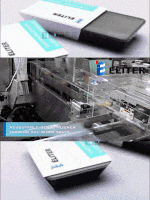Guarantee Food Safety with Artificial Vision
2022-12-08
What is artificial vision? What are the uses of artificial vision in the food sector?
Topic: Prevent defects in your production
The government has put food manufacturers under the magnifying glass to ensure that they follow food safety standards and comply with regulations. When it comes to the health and safety of consumers, quality assurance is a top priority, but despite this, according to the World Health Organization, approximately 600 million people get sick every year after eating contaminated food, and 420,000 die.
The use of human manual inspection for quality controls in this industry can be detrimental to any company and its consumers due to human error, fatigue and subjective judgments. In addition, foreign particles that should not be found in the product can be microscopic and invisible to the human eye. These defects can lead to illness, recalls, lawsuits and a long-term negative perception of the brand itself. Food and beverage manufacturers need to realize these potential risks and review the benefits of incorporating machine vision. Although the implementation of computer vision may seem like an expensive investment, it is a small price to pay compared to the potential harm of undetected problems. Here are some of the benefits that machine vision offers in the packaging, food and beverage industries.
Security
Consumers expect and trust safe products from food manufacturers. Machine vision can see through the packaging to determine the presence of foreign particles that should not be present, ensuring that these products are removed from the production line. Machine vision is also capable of inspecting for cross-contamination, color correction, ripeness and even deterioration. For example, bruises on apples can be difficult for the untrained eye to detect, unless they are extremely pronounced. SWIR (shortwave infrared) illumination is effective for the detection of defects and contamination. Subfloor bruising defects become much easier to detect due to the optimization of lighting and these defective products can be discarded.
Uniformity of Containers
In terms of marketing, brand positioning is a very important issue for manufacturers in this industry. Products that have defects such as dents or uneven contents inside the container can greatly affect the public’s perception of the product and/or the company. Machine vision can detect even the slightest deformity in the container and ensure that they are removed from the line. You can also scan the inside of the container to make sure the product is uniform for each batch. Vision systems have the ability to optimize the intensity, uniformity and geometry of lighting to obtain images with good contrast and signal to noise. Having the ability to alter the lighting provides a much clearer picture of the point of interest. This can allow you to see the inside of a container to determine if the fill level is correct for the specific product.
Packaging
Packaging is important because if the goods sent to the store are regularly defective, the store may choose to stop selling that item, costing the manufacturer valuable business. The seal must last from production to arrival at the store to ensure that the product maintains its safe usability until its marked expiration date. In bottling applications, conveyors move at high speeds, so the inspection process must be able to identify defects quickly and correctly. A facility in Marseille, France, was looking to inspect Heineken beer bottles as they passed through a bottling machine at a speed of 22 bottles/second (80,000 bottles/hour). Although it is at the faster end of the spectrum, many applications require high-speed quality controls that are impossible for a human operator. A machine vision system can be configured to handle these high-speed applications and teach it to detect the specified defect.
Label
It is critical that labels are printed correctly and placed on the correct product due to the food allergy threats experienced by some consumers. Machine vision can also benefit this aspect of the production process, as cameras can be taught to recognize the correct label and brand guidelines. Usually, these production lines move at speeds too fast for human inspection. An intuitive and easy-to-use computer vision software package allows you to filter the labels, find the object using waypoints and validate the text quickly and accurately.




